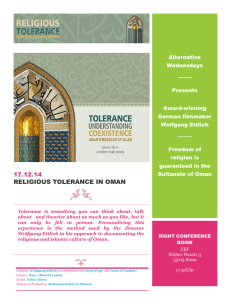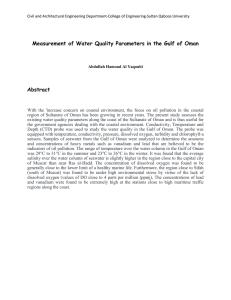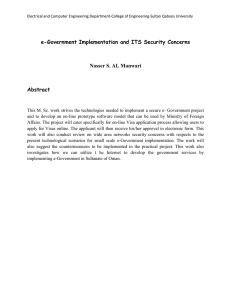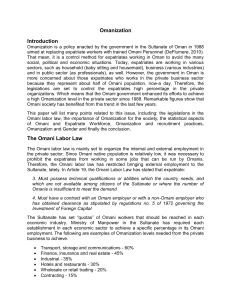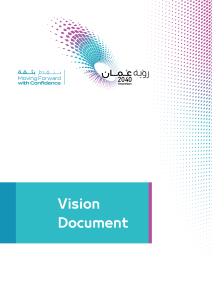2014 Funded by His Majesty’s annual grant which was launched in... projects are part of the most important research efforts conducted...
advertisement
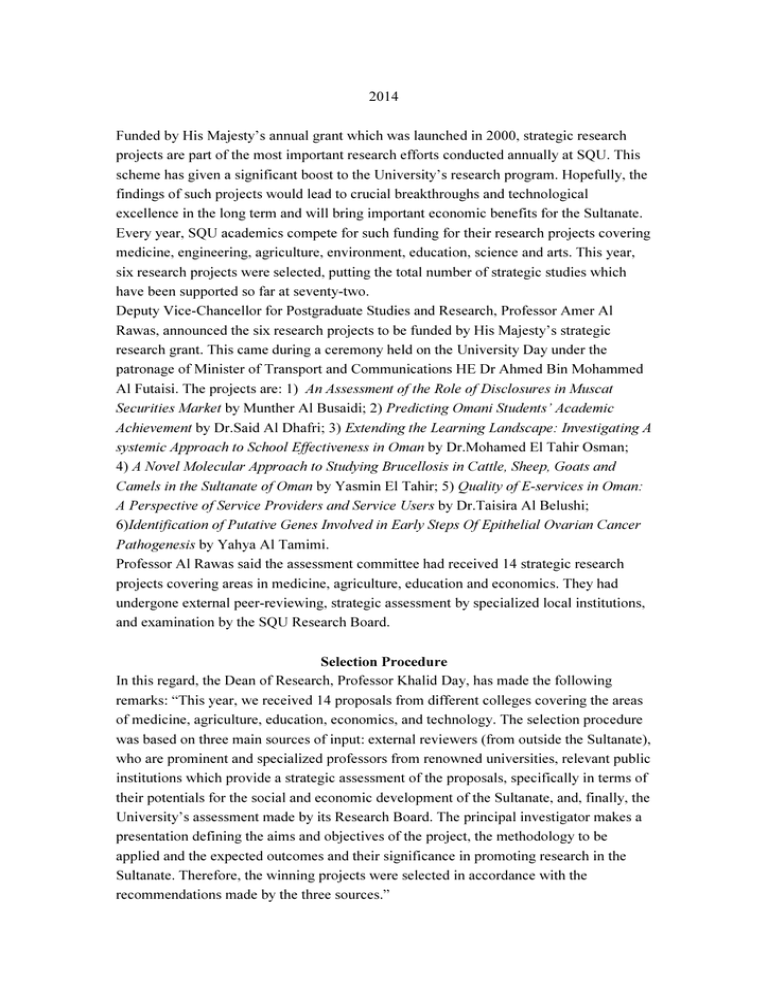
2014 Funded by His Majesty’s annual grant which was launched in 2000, strategic research projects are part of the most important research efforts conducted annually at SQU. This scheme has given a significant boost to the University’s research program. Hopefully, the findings of such projects would lead to crucial breakthroughs and technological excellence in the long term and will bring important economic benefits for the Sultanate. Every year, SQU academics compete for such funding for their research projects covering medicine, engineering, agriculture, environment, education, science and arts. This year, six research projects were selected, putting the total number of strategic studies which have been supported so far at seventy-two. Deputy Vice-Chancellor for Postgraduate Studies and Research, Professor Amer Al Rawas, announced the six research projects to be funded by His Majesty’s strategic research grant. This came during a ceremony held on the University Day under the patronage of Minister of Transport and Communications HE Dr Ahmed Bin Mohammed Al Futaisi. The projects are: 1) An Assessment of the Role of Disclosures in Muscat Securities Market by Munther Al Busaidi; 2) Predicting Omani Students’ Academic Achievement by Dr.Said Al Dhafri; 3) Extending the Learning Landscape: Investigating A systemic Approach to School Effectiveness in Oman by Dr.Mohamed El Tahir Osman; 4) A Novel Molecular Approach to Studying Brucellosis in Cattle, Sheep, Goats and Camels in the Sultanate of Oman by Yasmin El Tahir; 5) Quality of E-services in Oman: A Perspective of Service Providers and Service Users by Dr.Taisira Al Belushi; 6)Identification of Putative Genes Involved in Early Steps Of Epithelial Ovarian Cancer Pathogenesis by Yahya Al Tamimi. Professor Al Rawas said the assessment committee had received 14 strategic research projects covering areas in medicine, agriculture, education and economics. They had undergone external peer-reviewing, strategic assessment by specialized local institutions, and examination by the SQU Research Board. Selection Procedure In this regard, the Dean of Research, Professor Khalid Day, has made the following remarks: “This year, we received 14 proposals from different colleges covering the areas of medicine, agriculture, education, economics, and technology. The selection procedure was based on three main sources of input: external reviewers (from outside the Sultanate), who are prominent and specialized professors from renowned universities, relevant public institutions which provide a strategic assessment of the proposals, specifically in terms of their potentials for the social and economic development of the Sultanate, and, finally, the University’s assessment made by its Research Board. The principal investigator makes a presentation defining the aims and objectives of the project, the methodology to be applied and the expected outcomes and their significance in promoting research in the Sultanate. Therefore, the winning projects were selected in accordance with the recommendations made by the three sources.” Assessment of the Role of Disclosures in Muscat Securities Market Munther Al Busaidi says firm disclosures play a vital role in capital markets as they result in a better allocation of resources and added credibility to firms annual reports. This is accomplished through transferring a firm’s private information into public information. He argues that the status of disclosure practice in Muscat Securities Market (MSM) appears as a concern for the local investment community as highlighted by calls to improve disclosures and enforcements. His research addresses such concern by investigating how disclosure enhances the information set available to investors at MSM and what are the firm-specific determinants of disclosures. The results of this project will assist the Capital Market Authority (CMA) in evaluating the overall disclosure practice in Oman. It will also develop a mechanism to construct a disclosure index for firms listed on MSM. This index should serve as a benchmark for the market and motivate firms to improve their disclosures. Predicting Omani Students’ Academic Achievement Dr.Said Al Dhafri and his team aim to predict students’ academic achievement using a model that includes three important teachers’ variables: Teachers’ quality of life, their self-efficacy beliefs and their emotional intelligence. The investigation is important, says Dr Al Dhafri, given the vital role of students’ academic achievement (as a dependent variable) and its possible teacher-related predictors (quality of life, efficacy and emotional intelligence) that were found to influence teachers’ performance, motivation and decisions to stay in the teaching profession, especially in an era of rapid economic, social and cognitive changes. The team will use international measures as well as some newly designed ones to achieve the study goals. The study sample will consist of 10% of the total Omani teachers, to be selected from a random sample of schools across all Omani school districts. Both descriptive and inferential statistics will be used in data analyses. In addition to the quantitative measures, the researchers will use a qualitative approach to have an in-depth understanding of the teachers’ quality of life, efficacy beliefs and emotional intelligence and how they influence students’ academic achievement. Furthermore, the researchers will design and test the effectiveness of a training program designed to improve teachers’ quality of life, self-efficacy belief levels and emotional intelligence. The work is expected to contribute to a better understanding of the factors influencing students’ academic achievement and Omani teachers’ quality of life; an achievement that will be very valuable for Omani policy makers to develop strategies that ensure high quality teachers as an important factor in increasing students’ academic achievement and learning. Extending the Learning Landscape in Oman In this study, Dr Mohamed El Tahir Osman aims to systemically activate and analyze the impact of all interrelated elements in the school system that promote the empowerment of student learning in the Sultanate of Oman. More specifically, it seeks to furnish the school system with a practical model for sustained improvement of the overall school performance. It is hypothesized that any sustained improvement in the school system is a function of a set of interrelated driving forces or subsystems that collectively drive the overall performance of the school system, and impact students’ learning potential. It is hoped that this project will contribute to the efforts exerted by the Education Council and the Ministry of Education to heed the call of His Majesty Sultan Qaboos bin Said for securing the quality of outputs of all types of educational establishments in accordance with the general policies of the State. A descriptive analytic methodology which draws upon mixed methods of quantitative and qualitative data will be used. The project has three phases each of which will require different types of design (e.g. descriptive analytic, experimental, and ethnographic). The sample will include four schools (two male and two female) from Muscat area. About 3600 students from grades 5 -10 will be tested and followed up at three stages: grades 5-6, 7-8, and 9-10. The sample will also include all teachers, administrators and parents of children in these schools. A Novel Molecular Approach to Investigating Brucellosis The research project aims to establish the true incidence of brucellosis in sheep, goat, cattle and camels in different regions of the Sultanate of Oman. The researcher Yasmin El Tahir points out that, in the past, such an attempt was not possible because of the use of outdated serological methods that are less than adequate in the validity of the information they provide. This is due to a number of reasons. Firstly, vaccinated animals could not be differentiated from naturally infected ones. However, in a preliminary study, we demonstrated that a unique structural protein of Brucella (Bp26) not only binds to a number of host tissues but also allows the differentiation of vaccinated animals from naturally infected ones. This was a milestone because whereas the former do not represent a human health hazard the latter are potential source of infection for both animals and man. She continues: “Similarly, and perhaps more important is that until recently, the technology did not exist to appropriately identify the most important source of infection and transmission of this disease, namely carrier animals. These are animals that are infected but are apparently clinically normal.” Quality of E-services in Oman In this study, Dr.Taisira Al Belushi seeks to investigate the most important quality factors (i.e. usability, accessibility, security, etc.) when providing e-services from the service providers perspective as well as how these quality factors are measured and controlled. She will assess the quality of the current public e-services using web diagnostic tools and service users’ perception through qualitative surveys. Based on the findings, the study will propose a common quality framework for e-service that takes into account both perspectives of service providers and users in public sectors in order to help government organizations to provide improved quality services to the public. Identification Of Putative Genes Involved in Ovarian Cancer Yahya Al Tamimi will try to identify the putative genes involved in the early steps of Epithelial ovarian cancer (EOC). Early diagnosis seems to be of importance since complete cure can reach up to 90% if the disease is diagnosed at an early stage. Therefore, biological markers to detect patients at an early stage of the disease progression are urgently needed. In this study, Dr Al Tamimi proposes two independent ways to search for relevant biomarkers that can improve survivals. The first part will focus on a panel of genes, notably E2F5, FAT4 and ARID1A, selected after an “in silico” search of recent reports and available databases. Their possibility of being used as potential biomarkers, either individually or combined will be assessed and compared to the conventional serum marker CA-125. The second section of this proposal will be dedicated to chromatin immuno-precipitation using appropriate ovarian cancer cell lines (e.g. NIH:OVCAR-3) and an antibody against E2F5 transcription factor. The enriched chromatin will be cloned and sequenced before using available databases for BLAST and identification of downstream regulated genes. A short list of relevant genes will be obtained and analyzed for their putative role in early detection of EOC and therefore their possibility to be used as biomarker.

